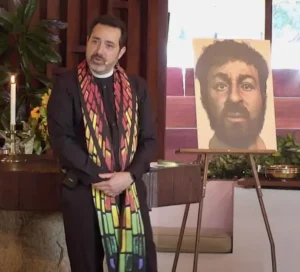
In Matthew 16:15, Jesus asks the disciples a question. He asks, “Who do you say that I am?” So, that’s the question I’d like to ask you today: Who do you say Jesus is?
When you close your eyes and pray to Jesus, to whom are you speaking? Who are you imagining in your mind’s eye?
When I was growing up, we had a picture of Jesus on the wall of every classroom in the Catholic school I attended. It pictured a handsome, white, blonde-haired, blue-eyed Jesus.
But, you know, this is not what most historians say the real Jesus looked like.
A few years ago for National Geographic magazine, a group of the world’s leading historians, Biblical scholars, theologians, and anthropologists got together to discuss and imagine what Jesus would have really looked like.
The image they came up with was of a poor, dark-skinned man with Middle Eastern features. Looking at the image in the magazine, I couldn’t help but think that most Christian in America today wouldn’t want a guy like this sitting next to them on an airplane. They wouldn’t want a guy like this walking around their neighborhood at night or living next door to them. Some of them might even want to ban a guy like this from entering our country.
You may be thinking, “Who cares what Jesus looked like? Why does it even matter?” Well, I believe it matters a great deal.
You see, I believe that if we had been raised with a more accurate image of Jesus in our illustrated children’s Bibles, in the stained glass windows of our churches, in our homes, on our TV screens, than we would be much more compassionate and concerned about “the other”…about those who are different from us.
If we grew up with a more accurate image of Jesus, we wouldn’t be so afraid and judgmental when we saw the Middle Eastern man on the airplane, or the homeless person in our neighborhood, or the young refugee family crossing the border.
Instead, we would recognize the Christ in our midst, and that, I believe, would make us much more compassionate, much more accepting, much more inclusive, and much more loving.
Sadly, though, if the real Jesus came back today, I think most Christians in America probably wouldn’t even recognize him. Jesus, you see, wasn’t white, wasn’t rich, wasn’t American, wasn’t Christian, and didn’t speak English.
Jesus was a poor, dark-skinned, Middle-Eastern refugee, whose name was Yeshua. He spoke Aramaic, and he led a revolutionary movement of the marginalized and the oppressed.
He criticized the rich and the powerful. He said he was going to bring about a new world order in which, he said, “the last would be first,” and the “least of these” would be given the most importance.
He bravely spoke truth to the religious leaders and political authorities of his day. He called them “hypocrites” to their faces. He challenged their authority so much, that they needed to silence him, arrest him, and eventually have him killed.
My friends, if we are to truly call ourselves Christians (which means “little Christs”) then we better know who Jesus really was, so that we can more fully follow in his steps.
Throughout his ministry, Jesus was asked (time-and-time again): “Who are you?” They asked him, “Are you a Prophet?” “Are you a Messiah?” “Are you the Savior?” And Jesus never once accepted any of those titles. He didn’t think of himself as Lord, Master, or King.
Instead, he said this: He said, “I am the Way.”
Jesus wanted us to follow his Way…his way of living, his way of loving, his way of forgiving, his way of serving. Jesus wanted us to feed the hungry; to care for the sick; to welcome to stranger; and to free the oppressed.
One of our UCC leaders, Rev. Traci Blackmon, said: “Most of Jesus’s public ministry was spent reaching out to those who were ignored in the community and underserved by the ruling class. In my quest to follow him, I am compelled to do the same.”
Jesus, my friends, wanted us to do as he did. He didn’t want us to worship him, he wanted us to follow him.
The contemporary Christian author, Father Richard Rohr says, “Jesus doesn’t want FANS. Jesus wants followers.” He writes: “We worshipped Jesus instead of following him on the same path. We made Jesus into a mere religion instead of a journey to union with God and everything else. This shift made us into a religion of belonging and believing, instead of a religion of transformation.”
My friends, if being a Christian is not transforming you — making you more loving, more forgiving, more accepting, more compassionate of “the other” — than you’re doing Christianity wrong.
And so, this week, I’d like to invite you to get to know the real Jesus a little bit better. Spend some time looking at images of Jesus that are different than the ones you grew up with. There are so many beautiful works of art that you can find online and incorporate into your prayer time.
And, after you leave the meditation chair, may you then go out into the world each day to look for and to see the face of Christ more fully in one another, especially the least of these in our midst.
Let us pray that we will see Jesus more clearly, love Jesus more dearly, so that we can follow in his Way more nearly.
